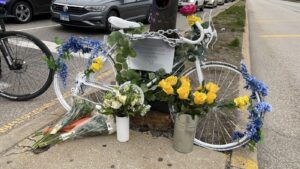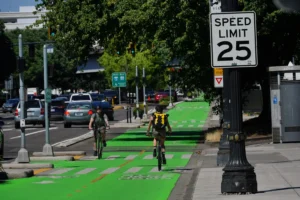
America is a suburban nation, where 35 mph is considered a minimum. Where two lanes are available each way, speeds of 50-60 mph are common. This is why 41,000 people died on American roads in 2023. Hundreds of thousands more are seriously injured, with consequences that last a lifetime.
The numbers have been going down as cities lowered speed limits to accommodate bicycles and other forms of e-transport.
E-bikes have governors that limit their assisted speed, usually to 20 mph. (In Europe it’s 15 mph.) This makes e-bike speeds compatible with traditional bikes and protects the walkers seen on most American bike paths.
But it won’t stay that way. New for 2025 are e-mopeds, fat-tired and high-powered, capable of going 35 mph, without pedaling. I’m seeing them more and more on Atlanta streets, and on the Atlanta Beltline. They’re being ridden by teenagers, and some of these kids are getting killed.
The problem of speeding, in other words, doesn’t just exist on our highways anymore. It’s everywhere.
Regulate Speed

Authorities in Mexico City and London are being driven crazy by these things. Crooks can modify the biggest, 120 pound models to achieve speeds of up to 70.
If we’re not all going to be the Netherlands, building separate path networks for walkers, bike riders and cars, we must enforce sensible speed limits on everyone. The chances that you’ll die in a crash drop dramatically when the speed of the crash is 20 mph or below.
On the Atlanta Beltline, anything going at over 20 mph, or 15 on the crowded East Side Trail needs to be ticketed. But ticketing doesn’t work without electronic enforcement, and bicyclists aren’t licensed. The easy answer is to call Class 3 e-bikes mopeds and force licensing on them, banning them from bike trails. You still need enforcement.
But now you have another problem. A moped moving at a top speed of 35 can use city streets, but it’s a hazard to suburban traffic because it’s so slow. Electric motors won’t be restricted by a legal definition, unless it’s enforced at the point of purchase.
Suburban America

Most of us never bike and seldom walk. Most get around exclusively inside cars, living rooms on wheels costing $50,000 and more. Many don’t even get out of their cars to eat. The online world is filled with trolls saying cities are awful, that driving is cheap.
The average American spent over $12,000 on transportation 2023, 93% of it on cars. It’s 16% of our spending every year. Those are just the direct costs. This doesn’t count the costs of road construction, maintenance, law enforcement, or crashes.
Drivers seem OK with this and will fight any enforcement of speed limits, even in school zones. They often win.
It’s at the borders of suburban America, with its total car dependence, and urban America, with its plethora of options, that the rubber is going to meet the road. Today’s message is slow the fuck down when you get into the city, just as you’re supposed to do on a country road when you get into town. (Many small rural communities enforce 25 mph speed limits.)
Next month I’m headed to the Netherlands, to learn what else can be done.










